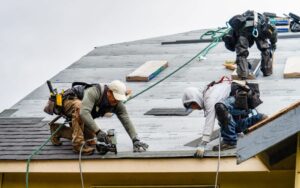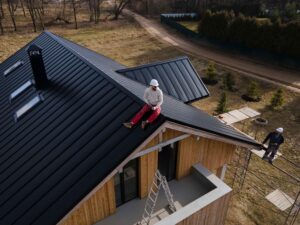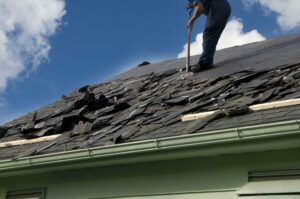When considering how long your roof should last, various factors come into play, including the materials used and local climate conditions. Different roofing materials have distinct lifespans, and understanding these can help you make informed decisions. Regular maintenance and inspections can also influence longevity. But how do you know when your roof is nearing the end of its life? Let’s explore the specifics that determine your roof’s durability.
What Determines a Roof’s Lifespan?
When considering what determines a roof’s lifespan, it’s essential to recognize that several factors come into play. The size and type of your roof notably affect inspection costs and overall maintenance. For instance, larger roofs require more time and effort for assessments, while steep pitches complicate inspections, increasing safety measures. Accessibility also plays a role; roofs that are difficult to reach may incur additional setup costs. In addition, the complexity of the roofing material influences the expertise required during inspections. Regular assessments, whether basic visual or advanced methods like infrared and drone, help identify issues early, preventing minor problems from escalating into costly repairs, ultimately extending your roof’s lifespan and protecting your investment.
Roof Lifespan by Material Type
Different roofing materials offer varying lifespans, which can greatly impact your long-term investment. Asphalt shingles typically last 15 to 30 years, depending on quality and installation. Metal roofs, known for their durability, can last 40 to 70 years with proper maintenance. Slate and tile roofs are even more resilient, often exceeding 50 years, but they come with a higher upfront cost. Wood shakes may last 20 to 40 years, but their longevity depends on climate and maintenance. Finally, single-ply membranes, popular in commercial applications, usually last 20 to 30 years. Understanding these lifespans helps you choose the right material based on your budget and longevity expectations, ultimately enhancing your home’s value and protection.
Signs Your Roof Is Nearing the End of Its Life
As your roof ages, it’s crucial to recognize the signs that indicate it’s nearing the end of its lifespan. Look for curling or missing shingles, which can suggest significant wear. Water stains on ceilings or walls often indicate leaks, while granules in gutters may signal shingle deterioration. You should also inspect for sagging or uneven areas, as these can point to structural issues. Additionally, if your roof is over 20 years old, it’s wise to schedule a professional inspection. Using advanced methods like infrared or drone inspections can uncover hidden problems. Regular assessments guarantee early detection of issues, helping you avoid costly repairs and maintain your home’s integrity. Stay proactive to safeguard your investment.
How to Extend the Life of Your Roof
Recognizing the signs that your roof is nearing the end of its life is only one part of responsible homeownership; knowing how to extend its lifespan is equally important. Start with regular roof inspections, ideally every few years, to identify issues early. Consider hiring professionals for advanced inspections like infrared or drone assessments, especially for complex roofs. Maintain clear gutters to prevent water damage, and guarantee proper ventilation to reduce heat buildup. Address minor repairs promptly to avoid escalation into costly fixes. Additionally, keep trees trimmed to prevent debris accumulation and damage from falling branches. Finally, invest in high-quality roofing materials when repairs or replacements are necessary, as these can greatly enhance durability and longevity.
When Should You Replace Your Roof?
When determining whether to replace your roof, it’s essential to assess its condition and age critically. If your roof is over 20 years old, you should consider a replacement, especially if it shows signs of wear, such as missing shingles or water stains inside your home. Regular inspections are important; a basic visual inspection can identify obvious damage, while advanced methods like infrared or drone inspections reveal hidden issues. If repairs exceed 30% of your roof’s value or if there are extensive leaks, replacement may be more cost-effective. Additionally, if your roof’s performance is compromised, delaying replacement can lead to more significant structural issues, escalating repair costs, and compromising your home’s safety.
Frequently Asked Questions
How Can I Tell if My Roof Needs Repair Instead of Replacement?
To determine if your roof needs repair instead of replacement, inspect for leaks, missing shingles, or sagging areas. If damage is localized and minimal, repairs can suffice; however, extensive issues may warrant replacement.
What Are the Costs Associated With Roof Replacement?
When considering roof replacement, you’ll encounter various costs, including materials, labor, permits, and disposal fees. Quality materials and experienced contractors usually increase upfront costs but can save you money on long-term repairs and maintenance.
Can I Install a New Roof Over My Existing One?
You can install a new roof over your existing one, but guarantee the current structure’s integrity. Check local building codes, consider weight limits, and assess proper ventilation to avoid future issues and guarantee longevity.
How Does Climate Affect Roof Longevity?
Climate greatly affects your roof’s longevity. Extreme temperatures, humidity, and precipitation can lead to accelerated wear. Choosing suitable materials and regular maintenance can help mitigate these effects, ensuring your roof remains durable over time.
What Warranties Are Typically Available for Roofing Materials?
Most roofing materials come with warranties ranging from 10 to 50 years. You’ll find manufacturer warranties covering defects, while workmanship warranties from contractors guarantee proper installation, safeguarding your investment against future issues. Always review warranty details carefully.




